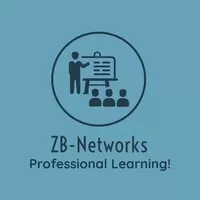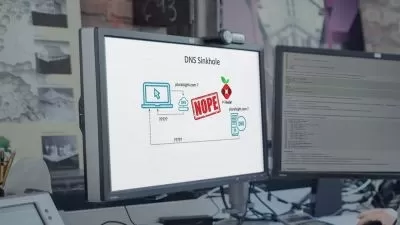Network Fundamentals for Absolute Beginners
ZB Networks 50000+ students trained Worldwide
18:38:38
Description
Networking fundamentals for beginners, learn how computer networks work, the architecture used to design networks.
What You'll Learn?
- Networking Overview
- Cabling and connectors
- Reference Models : OSI Model and TCP/IP Model
- IPv4 Addressing and subneting , VLSM
- Network Devices : Hub, Switch, Bridge, Router and Firewall - Overview
- IP Routing Overview
- Static Routing
- Default Routing
- Dynamic Routing Protocols : RIP, OSPF
- Switches Overview
- MAC Address and MAC Address Tables
- VLANs and Trunking
- Spanning-Tree Protocol (STP) and Types
- Etherchannel / Port-channel / Link-Aggregation
- Security Overview
- Port-security on Switches
- ACL on Routers
- NAT and PAT
- Wireless Networking
Who is this for?
What You Need to Know?
More details
DescriptionIn this introduction to networking, learn how computer networks work, the architecture used to design networks, and how to keep them secure.
Networking Fundamentals is a course for non-technical people. It is designed to provide a broad understanding of the basics of computer networks for Sales and Merchandising employees. Technical people may find it useful in establishing a baseline for knowledge before developing further networking skills or certifications.
This is a great starting point for learners who are interested in entry-level networking concepts and skills. This path is vendor-neutral and covers networking concepts and protocols, network infrastructure basics, networking management and operations, network security, and network troubleshooting and tools.
This path will get you started in Networking. You'll learn all the basics you need in order to pursue a career in Networking. This is a great starting point for learners who are interested in entry-level networking concepts and skills. This path is vendor-neutral and covers networking concepts and protocols, network infrastructure basics, networking management and operations, network security, and network troubleshooting and tools.
This foundational Networking Fundamentals prepares learners to implement, maintain, troubleshoot and repair computer and network systems by learning what different types of networks are and how they operate.
At its simplest, networking is just moving 0s and 1s from one machine to another. But it can also be the most complicated, nuanced, and technically challenging aspect of information technology.
After completing this networking training you'll know how to implement, maintain, troubleshoot and repair computer and network systems by learning what different types of networks are and how they operate.
For managers with network professionals, this training can be used to onboard new network technicians, curated into individual or team training plans, or as a reference resource.
You'll learn the fundamental principles of computer networking to prepare you for the Azure admin and developer learning paths.
Learning objectives
Networking Fundamentals Table of Contents :
- Networking Overview
- Cabling and connectors
- Reference Models : OSI Model and TCP/IP Model
- IPv4 Addressing and subnetting , VLSM
- Network Devices : Hub, Switch, Bridge, Router and Firewall - Overview
- IP Routing Overview
- Static Routing
- Default Routing
- Dynamic Routing Protocols : RIP, OSPF
- Switches Overview
- MAC Address and MAC Address TablesÂ
- VLANs and Trunking
- Spanning-Tree Protocol (STP) and Types
- Ether channel / Port-channel / Link-Aggregation
- Security Overview
- Port-security wrt Switches
- ACL wrt Routers
- NAT and PAT
- Wireless Networking
Lab Tools : Cisco packet tracer , GNS3 , EVE-NG
Who Should Take Networking Fundamentals Training?
This Networking Fundamentals training is considered foundational-level training, which means it was designed for network technicians with 6 months to 1 year of experience -- or no experience at all. This Networking Fundamentals course is valuable for new or aspiring IT professionals, experienced network technicians looking to validate foundational skills, and non-technical professionals.
Foundational networking user training. Understanding networking is simply essential for anyone who works with a computer. Learning the fundamentals of networking technology will do more than make you a better user of technology. It will give you an understanding of why security procedures are what they are, plus it'll highlight creative opportunities for you and your business.
New or aspiring IT professionals. If you've already been working as a network technician for some time, this course is the place to start if you want to lay a foundation for advancing into more meaningful, challenging, and higher-paying positions. If you jumped into technician work before you could learn the fundamentals of networking from the ground up, start here and you'll know which parts of the job to move into next.
===================================
*********Updated 11/11/22*************
Uploaded section "Network Topologies"
===================================
Who this course is for:
- Anyone who wants to learn Networking
In this introduction to networking, learn how computer networks work, the architecture used to design networks, and how to keep them secure.
Networking Fundamentals is a course for non-technical people. It is designed to provide a broad understanding of the basics of computer networks for Sales and Merchandising employees. Technical people may find it useful in establishing a baseline for knowledge before developing further networking skills or certifications.
This is a great starting point for learners who are interested in entry-level networking concepts and skills. This path is vendor-neutral and covers networking concepts and protocols, network infrastructure basics, networking management and operations, network security, and network troubleshooting and tools.
This path will get you started in Networking. You'll learn all the basics you need in order to pursue a career in Networking. This is a great starting point for learners who are interested in entry-level networking concepts and skills. This path is vendor-neutral and covers networking concepts and protocols, network infrastructure basics, networking management and operations, network security, and network troubleshooting and tools.
This foundational Networking Fundamentals prepares learners to implement, maintain, troubleshoot and repair computer and network systems by learning what different types of networks are and how they operate.
At its simplest, networking is just moving 0s and 1s from one machine to another. But it can also be the most complicated, nuanced, and technically challenging aspect of information technology.
After completing this networking training you'll know how to implement, maintain, troubleshoot and repair computer and network systems by learning what different types of networks are and how they operate.
For managers with network professionals, this training can be used to onboard new network technicians, curated into individual or team training plans, or as a reference resource.
You'll learn the fundamental principles of computer networking to prepare you for the Azure admin and developer learning paths.
Learning objectives
Networking Fundamentals Table of Contents :
- Networking Overview
- Cabling and connectors
- Reference Models : OSI Model and TCP/IP Model
- IPv4 Addressing and subnetting , VLSM
- Network Devices : Hub, Switch, Bridge, Router and Firewall - Overview
- IP Routing Overview
- Static Routing
- Default Routing
- Dynamic Routing Protocols : RIP, OSPF
- Switches Overview
- MAC Address and MAC Address TablesÂ
- VLANs and Trunking
- Spanning-Tree Protocol (STP) and Types
- Ether channel / Port-channel / Link-Aggregation
- Security Overview
- Port-security wrt Switches
- ACL wrt Routers
- NAT and PAT
- Wireless Networking
Lab Tools : Cisco packet tracer , GNS3 , EVE-NG
Who Should Take Networking Fundamentals Training?
This Networking Fundamentals training is considered foundational-level training, which means it was designed for network technicians with 6 months to 1 year of experience -- or no experience at all. This Networking Fundamentals course is valuable for new or aspiring IT professionals, experienced network technicians looking to validate foundational skills, and non-technical professionals.
Foundational networking user training. Understanding networking is simply essential for anyone who works with a computer. Learning the fundamentals of networking technology will do more than make you a better user of technology. It will give you an understanding of why security procedures are what they are, plus it'll highlight creative opportunities for you and your business.
New or aspiring IT professionals. If you've already been working as a network technician for some time, this course is the place to start if you want to lay a foundation for advancing into more meaningful, challenging, and higher-paying positions. If you jumped into technician work before you could learn the fundamentals of networking from the ground up, start here and you'll know which parts of the job to move into next.
===================================
*********Updated 11/11/22*************
Uploaded section "Network Topologies"
===================================
Who this course is for:
- Anyone who wants to learn Networking
User Reviews
Rating
ZB Networks 50000+ students trained Worldwide
Instructor's Courses
Udemy
View courses Udemy- language english
- Training sessions 118
- duration 18:38:38
- Release Date 2022/12/03











